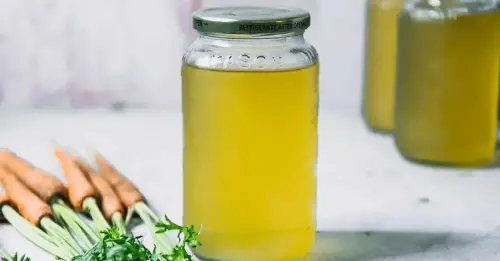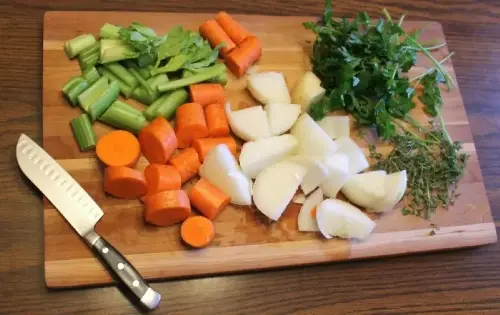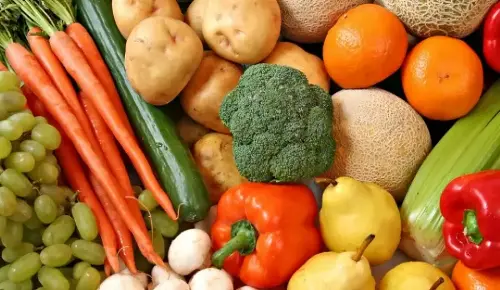Vegetable dashi is a type of water cooked from natural ingredients with a sweet and nutritious taste, often combined when preparing dishes for children. Parents should immediately refer to how to cook vegetable dashi for 6-month-old babies with the suggested recipes below.
1. What is vegetable dashi?
Vegetable dashi is a traditional broth in cuisine Japanese, made from fresh vegetables such as carrots, onions, celery... Not only does it make children's dishes more appealing, vegetable dashi also provides many vitamins and minerals essential for children's comprehensive development.

Vegetable dashi provides many essential vitamins and minerals.
When children enter the weaning stage, they should not use salt or other spices in food preparation and vegetable dashi is a very safe choice to help children's weaning meals become more diverse, rich and nutritious than ever. However, for children under 12 months old, you should not use dashi that is too concentrated to avoid harming the child's digestive system.
2. Principles when cooking vegetable dashi
To ensure nutritional effectiveness, when cooking vegetable dashi for your baby, mothers need to note the following important principles:
Some vegetables should not be combined together when cooking dashi stock.
Carrots and white radishes: White radishes contain a lot of vitamin C, but carrots contain an enzyme that can break down vitamin C. Therefore, when combining these two types of root vegetables together, not only will the vitamin C content from the radishes be lost, but it can also cause indigestion in children;
- Pumpkin and Chinese cabbage: Pumpkin contains an enzyme that can destroy vitamin C in Chinese cabbage. Therefore, mothers should avoid combining these two vegetables to avoid nutritional loss;
- Do not combine tomatoes, potatoes, and sweet potatoes: These 3 tubers when combined together can cause diarrhea in children;
- Tomatoes and cucumbers: Tomatoes are a rich source of vitamin C while cucumbers contain substances that break down vitamin C. When combined, they can reduce the vitamin C content of tomatoes.
How to store and thaw dashi
After cooking, let the dashi cool completely before pouring it into a glass jar or airtight container with a lid. Dashi can be stored in the refrigerator for about 3-5 days. If you want to store it longer, you can freeze it. Divide the dashi into ice cube trays or small ziplock bags, then put it in the freezer.
After freezing, to keep the dashi nutritious, when needed, mothers should steam it or transfer the dashi from the freezer to the refrigerator overnight, let the water melt slowly and use it the next day.
Diversify your vegetables
Depending on your baby's preferences, you can combine a variety of different vegetables and fruits such as sweet cabbage, chayote, cabbage... to supplement the necessary vitamins and minerals for your baby.

Diversify the types of vegetables when preparing dashi for children
Be careful not to choose vegetables that taste bitter or astringent so that your baby can enjoy them more easily.
3. Suggestions on how to cook vegetable dashi for 6-month-old babies
Besides its role and significance for health, how to cook vegetable dashi for 6-month-old babies is a topic that many parents are interested in learning.
Regarding how to cook vegetable dashi for 6-month-old babies, there are no required ingredients. Mothers can freely create recipes from different vegetables and fruits to create delicious and nutritious dashi recipes for their children's weaning meals.
Ingredients to be prepared
- melon
- Potato
- Sweet potato
- Corn
- Cabbage
- Chayote
- Carrot

There are many recipes for cooking vegetable dashi for 6 month old babies.
How to prepare
Choose fresh ingredients. After purchasing the ingredients, you need to clean them thoroughly. Peel the chayote, carrots, sweet potatoes and potatoes, then soak them in diluted salt water. Remove, drain and then cut into bite-sized pieces. Note that the ingredients should not be cut too small, as they will easily overcook, become mushy and make the dashi unclear.
Boil 800ml of water, then add corn, potatoes, sweet potatoes, chayote, and carrots first. Boil the mixture over medium heat for 20 minutes, then add the remaining ingredients. Continue cooking for about 10 more minutes and then turn off the heat. Let the dashi cool, then use a sieve to filter out the vegetable residue. Store the remaining water in the refrigerator for up to 1 week to ensure that the nutritional value is preserved.
4. Notes when using vegetable dashi for babies
To maximize the benefits, when giving your baby vegetable dashi, mothers should also pay attention to some important things as follows:
- Consult your doctor before giving your baby any type of broth, including vegetable dashi;
- You can gradually introduce dashi to your baby, starting with a small amount and monitoring your baby's reaction.
- Initially, dashi stock should be diluted with filtered water in a ratio of 1:1 or 1:2 to reduce the concentration;
- Each time you use it, just defrost a sufficient amount of dashi;
- When cooking dashi, mothers need to research which vegetables to combine together to get good results;
- Ingredients must be fresh and delicious. Dried foods may have spoiled and do not provide the necessary nutrients;
- Do not freeze too much dashi because leaving it for too long will not only cause the nutrients to be lost but also make it unsanitary;
- After thawing dashi, if you do not use it all, do not refreeze it;
- Although dashi stock is delicious, it is not recommended to feed your baby porridge cooked with dashi stock only. Your baby still needs to supplement the nutritional value of real foods such as vegetables, meat, fish or seaweed.
Hopefully the above recipes have helped parents "pocket" how to cook vegetable dashi for 6-month-old babies rich in nutrients. If you have any questions about using vegetable dashi in your baby's menu or need detailed advice on nutrition, please contact MEDLATEC Healthcare System via Call Center 1900 56 56 56 for advice and support.
Sources: https://medlatec.vn/tin-tuc/cach-nau-nuoc-dashi-rau-cu-cho-be-6-thang-tuoi-cha-me-nen-tham-khao